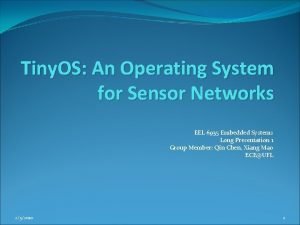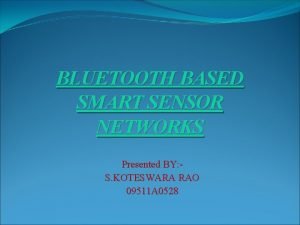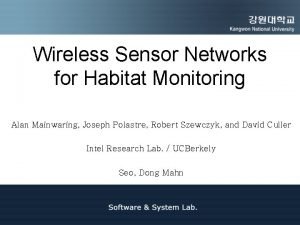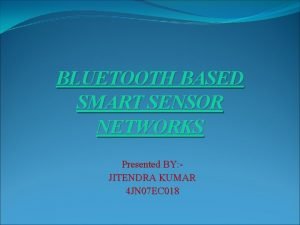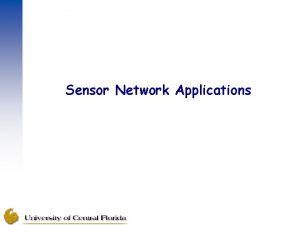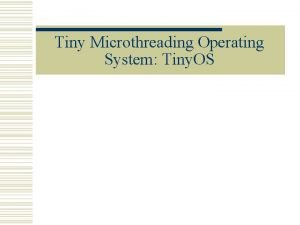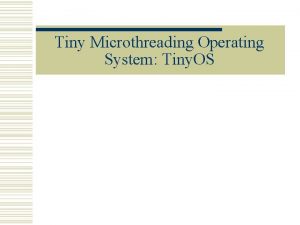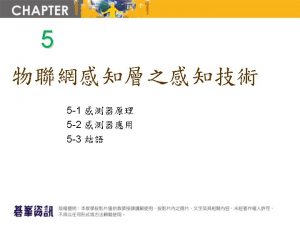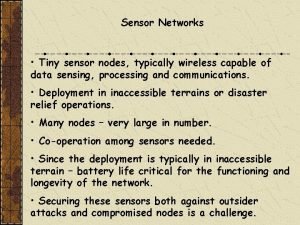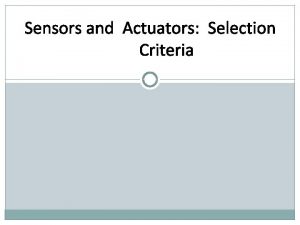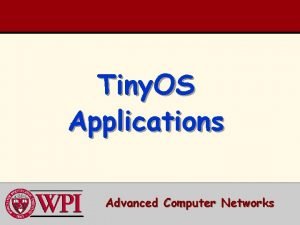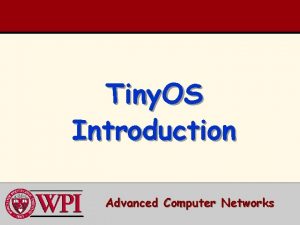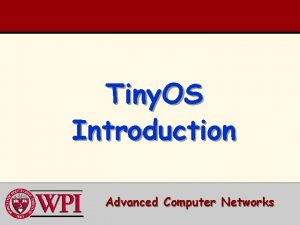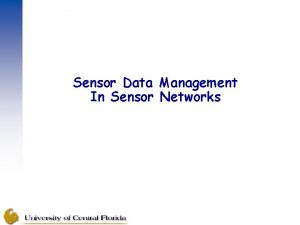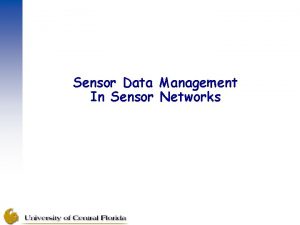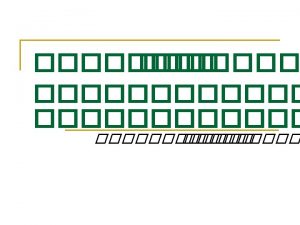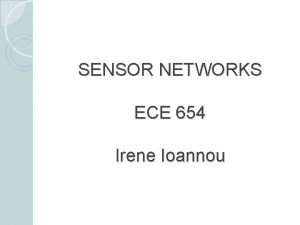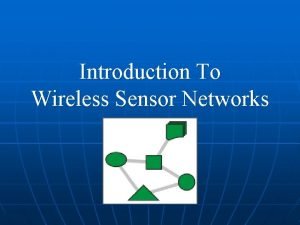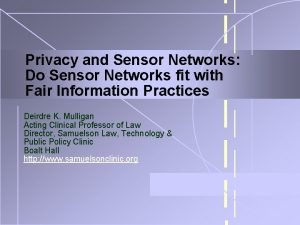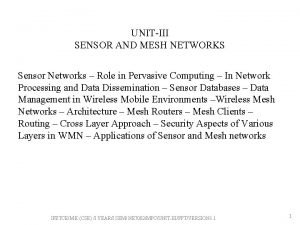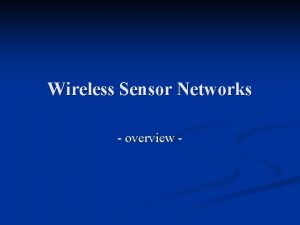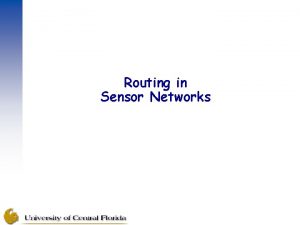Tiny OS An Operating System for Sensor Networks




















- Slides: 20

Tiny. OS: An Operating System for Sensor Networks EEL 6935 Embedded Systems Long Presentation 1 Group Member: Qin Chen, Xiang Mao ECE@UFL 2/5/2010 1

Outline �Motivation �Sensor node (mote) specifications �Four requirements �Design �Meet the four requirements �Performance �Applications �Summary 2/5/2010 2

Mote HW specifications Program memory: 128 KB RAM: 4 KB Power: two AA batteries Size: 1 by 1 inch Data rate: 38. 4 kbps 2/5/2010 3

Motivation �Why a new OS for sensor networks? 1) Limited resources � Small size, low cost and power consumption 2) Reactive concurrency � Many tasks � Real-time 3) Flexibility � HW and application variations 4) Low power � Low power operations � Flexible power management strategies 2/5/2010 4

Tiny. OS �Open source �Collaboration between UC, Berkeley, Intel, and Crossbow Technology �Widely used by over a hundred groups worldwide �Component based architecture �Programming language: nes. C �Supported development environment: Linux and Windows 2/5/2010 5

Main Concept Application = Collection of components + scheduler Compiled into a single executable Event-driven architecture Single shared stack 2/5/2010 Main (includes Scheduler) Application (User Components) Actuating Sensing Communication Hardware Abstractions 6

Component Model Component Computation entity Abstraction of HW resources Three abstractions Interface Command: downcall Event: upcall Task: computation Split-phase Interface Task Interface Modules and configurations 2/5/2010 7

Component Library �Network protocols �Distributed services �Sensor drivers �Data acquisition tools �Timers �Storage 2/5/2010 8

Execution Model events �Tasks Preempt POST �Run-to-completion �Non-preemptive FIFO scheduling commands �Atomic to each other Interrupts �Interrupt handlers Hardware �Signaled asynchronously by HW �CAN preempt tasks �Nes. C compiler prevents nearly all data races 2/5/2010 Tasks FIFO commands Time 9

Network Messages �Active message (AM) � 36 -byte packet with a 1 -byte handler ID �Event-driven �Handlers are registered to receive messages of a particular type �Provides an unreliable, single-hop datagram protocol �Higher-level protocol and multi-hop communication are built on top of the AM interface 2/5/2010 10

Comparison with Linux Tiny. OS Scheduling Preemptive, priority Non-preemptive FIFO Concurrency Process/thread Task IPC Pipe, socket, semaphore NA Networking Socket/TCP/UDP/IP Active massage MMU Yes NA I/O Blocking Split-phase Kernel/user space Yes NA 2/5/2010 11

Req 1: Limited Resources �Absolute size �Components are resolved at compile time �Application specific version � Base Tiny. OS < 1 KB � Most applications < 16 KB � Tiny. DB < 64 KB (largest Tiny. OS application) �Footprint Optimization �Stripping symbol table �Prune dead code �Cross-component optimization �Size improvement: 8% -- 60% 2/5/2010 12

Req 2: Reactive Concurrency �Concurrency exhibited by applications �Example: Tiny. DB �Race detection �Context switch �Task scheduling �Interrupt handler overhead �Real-time constraints �Burst of activities + lengthy idle interval �Time critical work + task 2/5/2010 13

Req 3: Flexibility �Fine-grained components �HW/SW transparency �Interposition 2/5/2010 14

Req 4: Low Power �Application specific �CPU power usage �Split-phase operation �Event driven execution �Low-power sleep mode �Power management interface �Stop and start command � 15 days --- 5 years �HW/SW transparency �Replace SW components with HW ones 2/5/2010 15

Applications �Habitat monitoring �Low power �Robust �Object tracking �High concurrency: routing, data sharing, time sync, localization, power management, and sensor filtering �Tiny. DB �Largest and most complex application �Concurrency control �Limited resources 2/5/2010 16

Summary �Small memory footprint �Application specific � Non-preemptive FIFO task scheduling �Power efficient �Application specific � Multi-level power management �Efficient modularity �Component architecture � Function call (event, command) interface between components 2/5/2010 17

Improvements �FIFO scheduling shortest first? Earliest deadline first, etc? 2/5/2010 18

References �Tiny. OS: An Operating System for Sensor Networks, Ambient Intelligence, 2005 �Tiny. OS tutorials, http: //docs. tinyos. net/index. php/Tiny. OS_Tutorials �http: //www. tinyos. net/ �http: //en. wikipedia. org/wiki/Tiny. OS �www. cs. virginia. edu/~cl 7 v/cs 851 talks/tinyos_chenyang. ppt 2/5/2010 19

Questions? 2/5/2010 20
 Tinyos operating system
Tinyos operating system Bluetooth based smart sensor networks
Bluetooth based smart sensor networks Single node architecture in wsn
Single node architecture in wsn Habitat monitoring sensor
Habitat monitoring sensor Bluetooth based smart sensor networks
Bluetooth based smart sensor networks Wireless sensor networks for habitat monitoring
Wireless sensor networks for habitat monitoring Differentiate between virtual circuit and datagram network
Differentiate between virtual circuit and datagram network Basestore iptv
Basestore iptv Buddy system operating system
Buddy system operating system File system in operating system
File system in operating system Ufs4.0
Ufs4.0 File system in operating system
File system in operating system Iso 22301 utbildning
Iso 22301 utbildning Typiska novell drag
Typiska novell drag Nationell inriktning för artificiell intelligens
Nationell inriktning för artificiell intelligens Returpilarna
Returpilarna Varför kallas perioden 1918-1939 för mellankrigstiden
Varför kallas perioden 1918-1939 för mellankrigstiden En lathund för arbete med kontinuitetshantering
En lathund för arbete med kontinuitetshantering Adressändring ideell förening
Adressändring ideell förening Tidbok för yrkesförare
Tidbok för yrkesförare Sura för anatom
Sura för anatom
